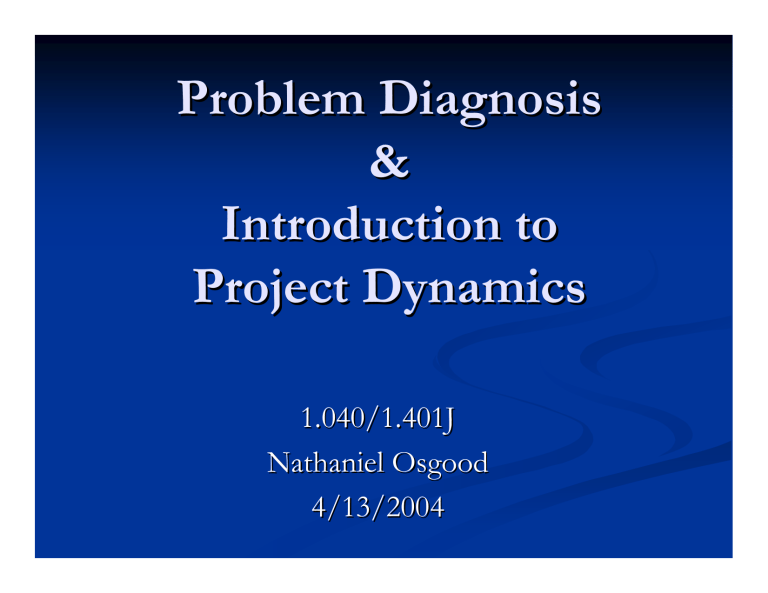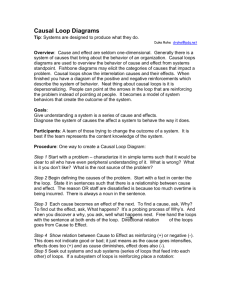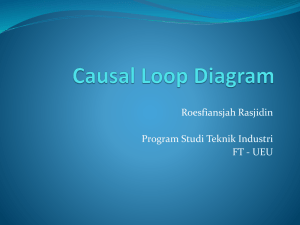Problem Diagnosis & Introduction to Project Dynamics
advertisement

Problem Diagnosis & Introduction to Project Dynamics 1.040/1.401J Nathaniel Osgood 4/13/2004 Topics Problem Diagnosis Pareto Analysis Fishbone Diagram Scatterplots Systems Thinking and System Dynamics Causal Loop Diagrams System Dynamics Insights into Causes of Problems Discussed Last Time : Exploratory Analysis Pareto Analysis Fishbone Diagram Scatter Diagram Causal Loop Diagram Pareto Analysis • • Correctly addressing a small portion of project components can provide control over the remaining project components. Help identify the contributors to given types of performance, mostly cost and quality performance. Group A: a small portion of the major cost components that account for a significant portion of the total cost Group B: all cost component other than Group A and C components Group C: a large portion of the minor cost components that account for a trivial portion of the total cost Pareto Analysis Example: Drivers of Quality Problems in Building Construction Workers Rebar workers Concrete workers Carpenters Mortar workers Frequency 10 15 20 5 Topics Problem Diagnosis Pareto Analysis Fishbone Diagram Scatterplots 9 Systems Thinking and System Dynamics Causal Loop Diagrams System Dynamics Fishbone (“Cause and Effect”) Diagram Help identify the drivers of given performance problems, by providing a format with which managers can easily understand cause and effect relationships. The causes for a given performance problem are analyzed by initially defining the problem and then channelling possible causal relations on the defined problem into predetermined (proj.-specfic)categories Subcauses shown as progressively refined branches Fishbone Diagram Example: Delay in concrete pouring Controllable Causes Workers Equipment Lack of Experience Hiring Temporary Workers Use of Inefficient Concrete Pump Low Productivity Late Arrival of Concrete Pump on the 1st Day Schedule Delay Rains in the Morning of the 3rd Day Uncontrollable Causes LEGEND Effects Categories 2nd Cause 3rd Cause 1st Cause Topics Problem Diagnosis Pareto Analysis 9 Fishbone Diagram Scatterplots 9 Systems Thinking and System Dynamics Causal Loop Diagrams System Dynamics Scatter Diagram Help predict the trend of future performance by showing the correlation between different variables. The data set used in a scatter diagram consists of an independent variable and a dependent variable Representing the independent variable on the horizontal axis and the dependent variable on the vertical axis, a scatter diagram can plot the correlation between two variables Scatter Diagram Different types of correlations Scatter Diagram Disadvantages Correlation does not necessitate a causal linkage Many potential directions of causal chains could explain a given correlation E.g. suppose A is correlated with B Possible Causal linkages A B B A A B B A C Topics 9 Problem Diagnosis Pareto Analysis 9 Fishbone Diagram 9 Scatterplots 9 Systems Thinking and System Dynamics Causal Loop Diagrams System Dynamics Systems Thinking and System Dynamics Systems thinking focuses on Conceptualizing problems in broader context Emphasizes interconnections rather than reductionist reasoning Internal rather than internal factors Feedback structure of system as primary determinant of behavior Common manifestations Qualitative: Causal loop diagrams Quantitative: System dynamics Systems Thinking and Project Management Primary critique: Traditional methods too Fragmented Restrictive in assumptions Local in attention to implications of changes Hesitant regarding representation of “soft” factors Too dependent on people link components Too willing to ignore important “side effects” Seen as potentially major contributor in project Learning (model captures institutional knowledge) Planning (identify robust decision rules, leverage pts) Control (how to best handle deviations) Critique of Fragmentation Consider traditional discrete methods CPM, Resource algs, time/cost tradeoffs, productivity considerations, manual check of global Activities analyzed in isolation (local impact of delaying activity or extending activity duration) Productivities, resource use, quality, cost all linked Delay/extension of activity influences resources, morale, productivity, etc. Takes people from other activities, idles others May affect customer relations, allocation of labor to project (⇒ lower quality) Requires reconsidering subcontractor, material procurement Makes overtime, concurrency more likely Typical schedulers do not think through all implications Plans is always changing, being updated Causal Loop Diagram Like fishbone diagram, focus on causation Contrast with correlation focus of scatterplot More general, expressive than fishbone Cyclic: Focus on capturing feedback effects Indicate sign of causal impact (+ vs. –) indicates x →+y ∂y >0 indicates ∂x x→y ∂y <0 ∂x Causal Loop Diagram An arrow with a positive sign (+): “all else remaining equal, an increase (decrease) in the first variable increases (decreases) the second variable above (below) what it would otherwise have been.” An arrow with a negative sign (-): “all else remaining equal, an increase (decrease) in the first variable decreases (increases) the second variable below (above) what it otherwise would have been.” Reasoning about Link Polarity Easy to get confused regarding link polarity in the context of a causal chain Tips for reasoning about link polarity for X→Y Reason about this link in isolation – do not be concerned about links preceding X or following Y Ask “if X were to INCREASE, would Y increase or decrease”? Increase in Y implies “+”, Decrease in Y implies “-” If answer is not clear or depends on value of X, need to think about representing several paths between X and Y Ambiguous Link Ambiguous Link: Sometimes +, sometimes Overtime Productivity Replace this by disaggregating causal pathways by showing multiple links Fatigue + - Overtime Productivity + + Longer Hours Feedback Loops Loops in a causal loop diagram indicate feedback in the system being represented Qualitatively speaking, this indicates that a given change kicks off a set of changes that cascade through other factors so as to either amplify (“reinforce”) or damp (“balance”) original change Loop classification: product of signs in loop Balancing loop: Product of signs negative Reinforcing loop: Product of signs positive Simple Causal Loops Worker Productivity Remaining Work + - Change Requests + Perceived Completion Date Perceived Slack + - + Project Duration Target Completion Date Job Rhythm - + Changes to Schedule Aggregate Productivity - - Willingness of Project Participants to share info with PM Overbearing PM Management Style - + PM Suspicion Estimated Design Costs beyond Target Budget Target Budget Design Scope + - Elaborating Causal Loops 1 + Estimated Design Costs beyond Target Budget Target Budget Design Scope + Target Budget - Estimated Design Costs beyond Target Budget Design Scope + Elaborating Causal Loops 2 Work Pressure + + Work Remaining - Productivity Work Pressure + + Fatigue + Work Remaining - Productivity Evolving More Complex Diagrams Relationship with Owner Relationship with Owner Labor Productivity - - Delay - + - + Morale Disputes with Owner + Disputes with Owner Schedule Pressure + + Relationship with Owner Labor Productivity + - Delay Delay - Morale - - Delay + - - + - Labor Productivity Concern About Cost of Delay Relationship with Owner - Disputes with Owner Morale + - Disputes with Owner Causal loop example T argeting early project completion - P roject scope completeness + Design change Design and construction requests from owner overlapping + - Schedule p ressure + Delay + + Design + completeness Design change requests from construction workers + + Construction+ change Design change Deadline and Milestone Control + Overtime Increasing + resources + Schedule slippage Schedule delays + + Time to completion - Aggressive scheduling Work remaining + - + Work rate + Productivity + Schedule pressure + Cutting the corner + Defects Causal Loop Structure : Dynamic Implications Each loop in a causal loop diagram is associated with qualitative dynamic behavior Most Common Single-Loop Modes of Dynamic Behavior Exponential growth Goal Seeking Adjustment Oscillation When composed, get mixture of behaviors e.g. Growth and Plateau CL Dynamics: Exponential Growth (First Order Reinforcing Loop) Example + Word of Mouth Sales + + Customers Graph for Stock Dynamic implications 20,000 15,000 10,000 5,000 0 0 10 Stock : Current 20 30 40 50 60 Time (Month) 70 80 90 100 CL Dynamics: Goal Seeking (Balancing Loop) Example: Dynamic behavior Potential - Customers Word of + Mouth Sales 75 50 25 0 0 10 20 Inventory : Current 30 40 50 60 Time (Month) 70 80 90 100 CL Dynamics: Oscillation (Balancing Loop with Delay) Causal Structure + Desires Inventory Inventory - Finishing + Producing Production + Starts demand vs. production Dynamic Behavior: 6,857 3,142 0 30 Time (year) demand : Oscil producing : Oscil tons/year tons/year Growth and Plateau Loop structure: Potential - Customers - Reinforcing Loop Balancing Loop Word of + Mouth Sales + + Dynamic Behavior: Customers + Graph for Customer 100,000 75,000 50,000 25,000 0 0 10 Customer : Current 20 30 40 50 60 Time (Month) 70 80 90 100 Design/Construction Overlap Uncertainties Assumptions in Design Owner's Requests on Changes Overlapping between Design and Construction Oversizing Project Costs Project Duration Potential Design Change Impact on Construction Construction Processes Design Changes Overlapping Construction Work R2 Done before Upstream Completed Increase in Time Pressure Workforce Estimated Project Duration R1 Delay Productivity R3 Construction Changes Construction Phasing Overlap Uncertainties Assumptions in Design Owner's Requests on Changes Overlapping between Design and Construction Oversizing Project Costs Potential Design Change Impact on Construction Construction Processes Overlapping R2 Project Duration Time Pressure Design Changes Construction Work Done before Upstream Completed Increase in Workforce R1 Estimated Project Duration Productivity Delay R3 Construction Changes Topics 9 Problem Diagnosis Pareto Analysis 9 Fishbone Diagram 9 Scatterplots 9 Systems Thinking and System Dynamics Causal Loop Diagrams System Dynamics 9 System Dynamics Many frameworks for project systems analysis Discrete event sim., Agent-based sim. System dynamics is most popular Greatest competitive advantage in systems that are Nonlinear Feedback rich Exhibit delays Less governed by low-level heterogeneity System Dynamics Basics Represents system as coupled series of ordinary differential equations (ODEs) Standard state-equation formulation Continuous time formulation Stochastic components permissible (special handling) Analytic solutions not possible: Numerically integrate Graphical representation for problem focus State equations as stocks Components of differentials as follows Intermediate computations as auxiliaries, table functions, etc. How a SD Model is Created Conceptualize system using causal loop diagram Convert CLD to “stock & flow” structure State variables (accumulations) as stocks Changes to state variables as flows All change in system state occurs through flows All loops include at least one stock Intermediate calculations, outputs as auxiliaries Add to equations to capture relations among vars Calibrate to historic data Run scenarios to identify effect, robust policies Example Creation of a System Dynamics Model Step 1: Map out Causal Loops Potential - Customers Word of + Mouth Sales + Customers Step 2: Identify state variables of interest Potential Customers + Customers Step 3: Identify flows of interest Potential Customers Customers New Customers + Example Creation of a System Dynamics Model Step 4: Define Supporting Variables Fraction of Customers in Population Total Population Likelihood of Potential Customer Joining Function Giving Likelihood of Potential Customer Becoming New Customer based on Fraction of Customers Potential Customers Customers New Customers Insert equations to describe linkages E.g. Total Population = Customers+Potential Customers Fraction of Customers in Population= Customers/Total Population Example Creation of a System Dynamics Model II Step 1: Map out Causal Loops Work Pressure Work Remaining Productivity Step 2: Identify state variables of interest Work Remaining Fatigue Step 3: Identify flows of interest Work Remaining Work Being Completed Fatigue Growth in Fatigue due to Schedule Pressure Fatigue + - + + Recovery from Fatigue Example Creation of a System Dynamics Model Initial Work Size Work Hours as a Function of Fraction of Work Fraction of Work Completed Completed Normal Productivity Work Remaining Work Hours Normal Work Hours Work Being Completed Productivity Coefficient as a Function of Direct Work Pressure Fatigue Growth in Fatigue due to Schedule Pressure Recovery from Fatigue Mean time to Recover From Fatigue Productivity Coefficient from Fatigue Productivity coeefficient from Fatigue as a Function of Fatigue




